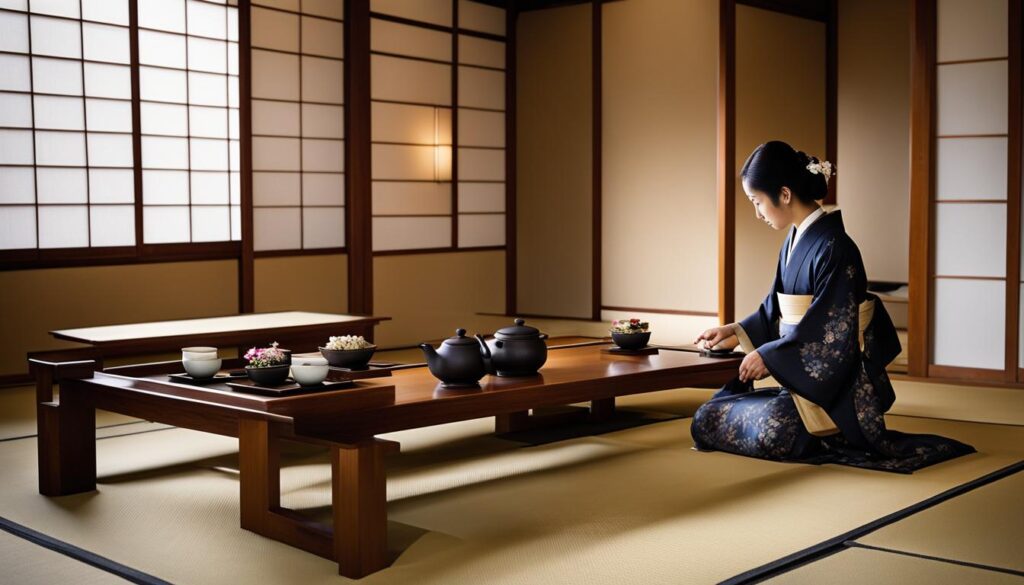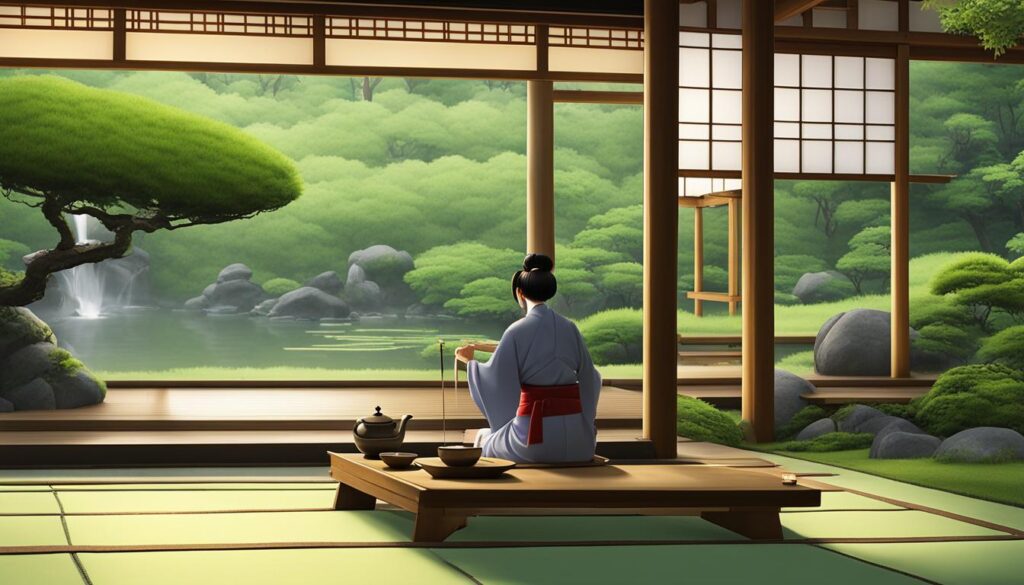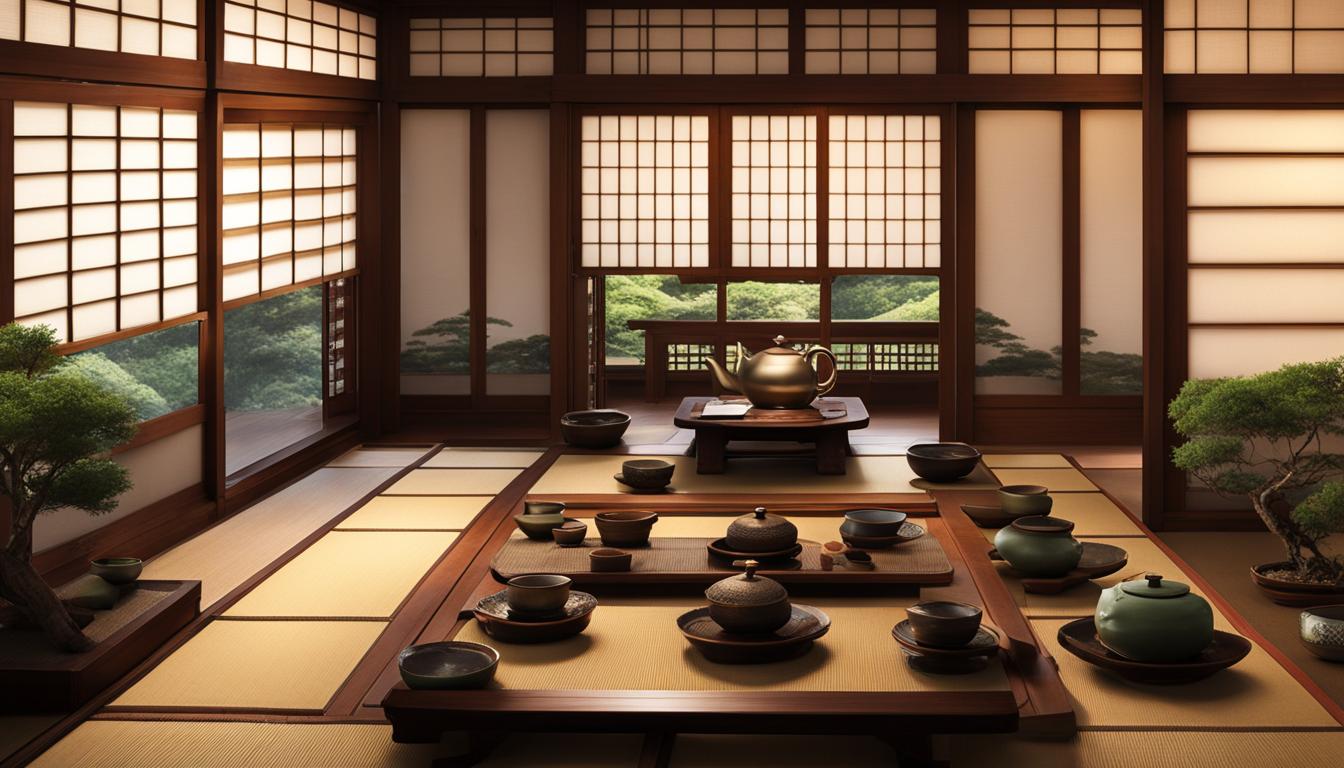The Japanese tea ceremony, also known as chado or sado, is a traditional practice deeply rooted in Japanese culture. It embodies ideals of tranquility, respect, purity, and reverence. In this section, we will explore the history of the Japanese tea ceremony, the essential tools and utensils required, the basic etiquette to follow, and the step-by-step process of hosting a tea ceremony. Whether you are a beginner or looking to deepen your understanding, this detailed guide will help you create an authentic and memorable tea ceremony experience.
Key Takeaways:
- Hosting a Japanese tea ceremony is a way to appreciate Japanese culture and traditions.
- Understanding the history and significance of the tea ceremony enhances the experience.
- Respecting the etiquette is crucial to creating an authentic and respectful tea ceremony.
- Attention to detail, from utensils to gestures and attire, ensures an immersive ceremony.
- Hosting a tea ceremony can be a rewarding and enriching experience for beginners and experienced hosts alike.
The History of the Japanese Tea Ceremony
The Japanese tea ceremony has a rich history that dates back centuries and is deeply intertwined with Japanese culture. Its origins can be traced back to China, where tea drinking was popularized during the Tang dynasty. The practice made its way to Japan in the 9th century, and over time, it evolved into the elaborate and ritualistic tea ceremonies that we know today.
During the Kamakura period (1185-1333), Zen Buddhist monks played a significant role in shaping the tea ceremony. They incorporated tea drinking into their religious practices as a means of achieving enlightenment and spiritual awakening. The tea ceremony became a way to cultivate mindfulness and a deep connection with nature.
Three prominent figures in the history of the Japanese tea ceremony are worth mentioning. First, Murata Juko (1423-1502) emphasized the role of the tea ceremony in achieving spiritual enlightenment. He believed that through the practice of tea, individuals could attain a state of tranquility and inner harmony. Another influential figure is Takeno Joo (1502-1555), who combined the tea ceremony with court poetry, creating a fusion of art and simplicity. Lastly, Sen no Rikyu (1522-1591) is regarded as the master who brought the tea ceremony to its pinnacle. He embraced the principles of wabi-sabi, emphasizing simplicity, imperfection, and the beauty of the imperfect. His teachings still shape the essence of tea ceremonies today.
The Japanese tea ceremony continues to be a cherished tradition that not only celebrates the art of tea but also embodies profound cultural values and philosophies. Understanding its history is crucial to fully appreciating the depth and significance of this time-honored practice.

Origins of the Japanese Tea Ceremony
The Japanese tea ceremony, also known as chanoyu or sadō, has its roots in China. Tea was introduced to Japan during the Tang dynasty, along with Buddhist teachings and other cultural influences. As tea drinking became popularized in Japan, it gradually evolved into a cherished practice that combined elements of spirituality, nature appreciation, and hospitality.
Prominent Figures in the History of the Tea Ceremony
The Japanese tea ceremony was shaped by the contributions of several key figures throughout history. Murata Juko, Takeno Joo, and Sen no Rikyu, each brought their unique perspectives and philosophies to the practice, influencing its development and defining its essence.
- Murata Juko (1423-1502): Emphasized the spiritual aspects of the tea ceremony, highlighting its potential for self-reflection and inner peace.
- Takeno Joo (1502-1555): Merged the tea ceremony with court poetry, infusing it with artistic expression and cultural refinement.
- Sen no Rikyu (1522-1591): Advocated for simplicity, imperfection, and a deep connection with nature, shaping the tea ceremony’s aesthetics and philosophy.
These influential figures laid the foundation for the tea ceremony as we know it today, and their teachings continue to inspire and guide practitioners.
Essential Tools for the Japanese Tea Ceremony
When it comes to hosting a traditional Japanese tea ceremony, having the right tools and utensils is crucial. Each item serves a specific purpose and contributes to the overall experience. Let’s take a closer look at the essential tools you’ll need to ensure an authentic and meaningful tea ceremony.
Chawan (Tea Bowl)
The chawan is a ceramic or porcelain bowl used to serve matcha, the powdered green tea. It is carefully selected for its shape, size, and aesthetic appeal, as it plays a significant role in the visual presentation of the tea. The bowl’s wide opening allows for the aroma of the tea to be enjoyed while the guests savor its flavors.
Chasen (Bamboo Tea Whisk)
The chasen is a handcrafted bamboo whisk used to prepare matcha. Its delicate and flexible bristles are carefully positioned to create a smooth and frothy texture. As you whisk the matcha and hot water together, the chasen helps to blend and aerate the tea, resulting in a rich and vibrant green color.
| Tool | Function |
|---|---|
| Chaki or Usuki (Tea Container) | Holds the matcha powder, ensuring it remains fresh and protected from moisture. |
| Chagama (Tea Pot) | Used to heat and pour hot water into the tea bowl during the ceremony. |
| Chashaku (Bamboo Tea Scoop) | Measures and scoops the appropriate amount of matcha powder for each serving. |
Image source: https://seowriting.ai/32_6.png
Japanese Tea Ceremony Etiquette
When participating in a Japanese tea ceremony, it is essential to follow the proper etiquette to show respect and appreciation for this ancient tradition. Here are some key guidelines to keep in mind:
A Dress Code for Elegance and Modesty
In the tea ceremony, guests are expected to dress modestly and elegantly. This means avoiding revealing or flashy attire. It is customary to wear subdued colors and clothing that allows for ease of movement. Some opt to wear a kimono, a traditional Japanese garment, to fully immerse themselves in the cultural experience. Remember to remove any jewelry and avoid wearing strong fragrances to minimize distractions during the ceremony.
Gestures and Rituals
The tea ceremony involves various gestures and rituals that reflect the principles of harmony, respect, purity, and tranquility. When entering the tea room, guests are expected to bow to the host as a sign of respect. Throughout the ceremony, guests should sit in the seiza position, kneeling with the legs tucked under the body. This posture helps maintain attentiveness and demonstrates reverence for the ceremony. It is customary to appreciate the tea room and its decorations, expressing gratitude to the host for the opportunity to participate.
The tea ceremony is a beautiful blend of mindfulness, tradition, and hospitality. Each gesture and ritual is imbued with meaning, creating an atmosphere of tranquility and connection.
Receiving and Drinking Tea
When receiving a bowl of tea, guests should hold the bowl with both hands to show respect and gratitude to the host. Before drinking the tea, it is customary to admire the appearance of the bowl, rotating it slightly to observe its design. When taking a sip, remember to do so quietly and without slurping. Take your time to savor the flavors and appreciate the effort the host has put into preparing the tea.
By following these guidelines, you can fully embrace the experience and show respect for the deep cultural significance of the Japanese tea ceremony. Remember, the rituals and gestures are not just formalities, but an opportunity to connect with the past and savor the present moment.

Conclusion
Organizing a Japanese Tea Ceremony can be quite an endeavor, but the rewards are truly worth it. Planning a traditional Japanese Tea Ceremony allows you to immerse yourself and your guests in the rich cultural heritage of Japan. To ensure a successful event, we have gathered some valuable hosting tips for you.
Firstly, it is crucial to pay attention to the details. From the selection of the essential tools and utensils to the proper attire and gestures, every element contributes to the authenticity and mindfulness of the ceremony. Remember, a well-organized and thoughtful tea ceremony will leave a lasting impression on your guests.
Additionally, understanding the history and significance of the tea ceremony is essential. Knowing the origins and the influential figures behind this tradition will add depth and meaning to the experience. By sharing this knowledge with your guests, you create an educational and culturally enriching environment.
Lastly, always remember to respect and follow the Japanese Tea Ceremony etiquette. Whether it’s dressing appropriately, entering the tea room with a bow, or expressing gratitude to the host, adhering to the customs will ensure a respectful and authentic tea ceremony. These small details play a significant role in maintaining the tranquility and reverence of the ceremony.
FAQ
What is the history of the Japanese tea ceremony?
The Japanese tea ceremony has its roots in China and was introduced to Japan during the Tang dynasty. It gained popularity during the Kamakura period, with Zen Buddhist monks incorporating tea drinking into their religious practices. The three most influential figures in shaping Japanese tea culture were Murata Juko, Takeno Joo, and Sen no Rikyu.
What tools and utensils are essential for a Japanese tea ceremony?
Essential tools and utensils for a Japanese tea ceremony include matcha powdered green tea, fukusa silk cloth for purifying the tools, chaki or usuki tea container, chagama tea pot, chashaku bamboo tea scoop, chawan tea bowl, and chasen bamboo tea whisk.
What is the etiquette to follow during a Japanese tea ceremony?
The Japanese tea ceremony has a set of etiquette and customs to follow, including appropriate attire, such as wearing modest clothing or a kimono, removing jewelry, and avoiding strong fragrances. Guests should also enter the tea room with a bow, sit in the seiza position, appreciate the tea room’s decor, and express gratitude to the host.
How can I host a Japanese tea ceremony?
Hosting a Japanese tea ceremony can be a rewarding and enriching experience. By following our step-by-step guide, understanding the history and significance of the ceremony, and respecting the etiquette, you can create an authentic and memorable tea ceremony experience.
What is the purpose of hosting a Japanese tea ceremony?
Hosting a Japanese tea ceremony allows you to share Japanese culture and traditions with your guests while fostering a sense of tranquility and mindfulness. It is a wonderful way to appreciate the beauty and serenity of this long-standing tradition.





